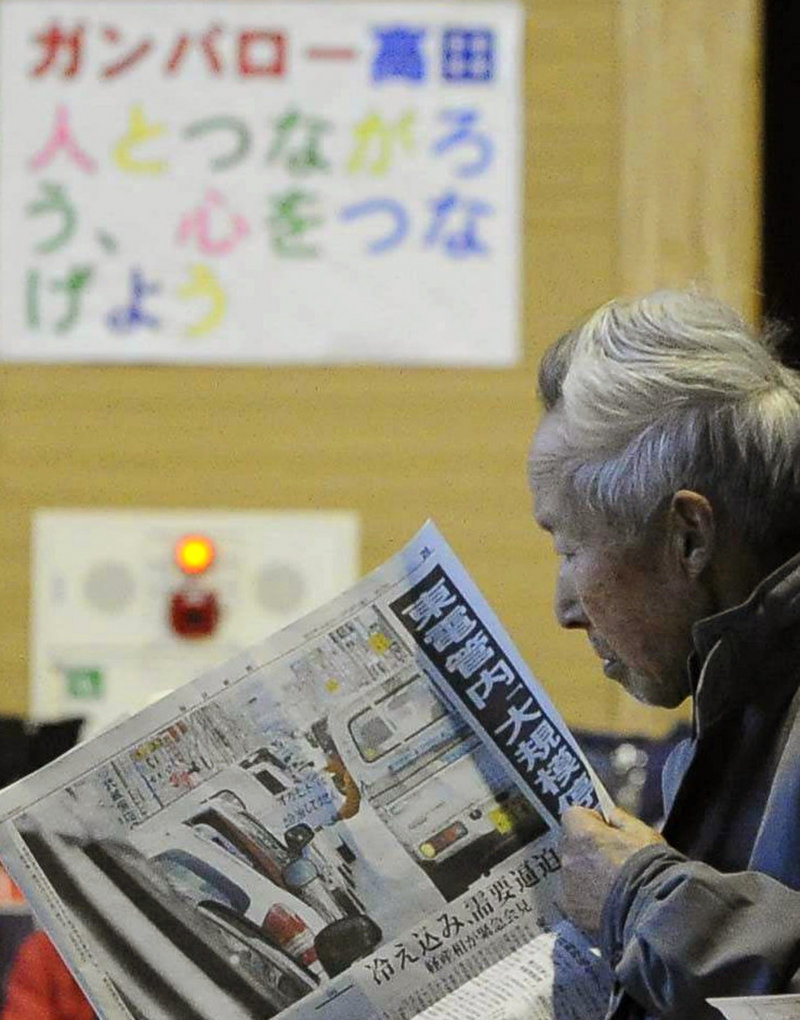ISHINOMAKI, Japan — Nobody tweeted or blogged or emailed. They didn’t telephone, either. Bereft of electricity, gasoline and gas, this tsunami-traumatized city did things the really old-fashioned way — with pen and paper.
Unable to operate its 20th-century printing press — never mind its computers, website or 3G mobile phones — the city’s only newspaper, the Ishinomaki Hibi Shimbun, wrote its articles by hand with felt-tip pens on big sheets of paper.
But unlike modern media, the method worked.
“People who suffer a tragedy like this need food, water and, also, information,” said Hiroyuki Takeuchi, chief reporter at the Hibi Shimbun, an afternoon daily. “People used to get their news from television and the Internet. But when there is no light and no electricity, the only thing they have is our newspaper.”
While recent political ferment across the Arab world has trumpeted the power of new media, the misery in Japan, one of the world’s most wired nations, has rolled back the clock. For a few days at least, the printed and handwritten word were in the ascendant.
After writing, Takeuchi and other staff copied work onto sheets by hand for distribution to emergency relief centers housing survivors of Japan’s worst-ever earthquake and deadly tsunami that followed.
“They were desperate for information,” said Takeuchi, who has slept in the office for the 10 days since the tsunami flooded the ground floor of his house.
With electricity now restored to about a third of the northeast city’s 160,000 residents, Takeuchi’s newspaper has again started printing. Internet access is still not available. Monday’s printed front page cheered a “miraculous rescue drama” — the story of a local 80-year-old and her 16-year-old grandson plucked Sunday from their ruined home.
Down the coast in Sendai, a once-thriving city of more than 1 million, the digital juggernaut has also come to a halt. “In conditions like these, nothing has power like paper,” said Masahiko Ichiriki, president and owner of Kahoku Shimpo, the city’s main newspaper. With most shops shut, people can’t buy batteries to power radios.
The collapse of the region’s electrical system has shut down Sendai’s computers and television sets, but Ichiriki’s Sendai newspaper has published throughout. It even put out a single-page flash edition on the evening of the tsunami.
Information-starved residents, said the proprietor, “depend on our newspaper for a lifeline.” It provides not only news about a catastrophe but also mundane, vital information: which shops have food, which roads have been cleared of rubble, which banks have cash and which branches of a popular liquor store have reopened.
In Ishinomaki, which is smaller than Sendai and suffered more damage, the Hibi Shimbun didn’t publish for two days after the tsunami. One of its six reporters was swept away in his car while returning from an assignment. He survived and, after several days in a hospital, is back at work.
Takeuchi, the chief reporter, was in the office when the earthquake struck at 2:46 p.m. on March 11. He had just finished work on that day’s edition, which featured a front-page article about Ishinomaki’s “hidden charms” and officials’ promises to improve hospital and other facilities.
The quake shook the newspaper’s two-story building so hard that fluorescent lights fell from the ceiling and filing cabinets skidded across the floor.
The first handwritten edition, prepared March 13, featured a pledge to “try and get information as accurate as possible.” It reported on the arrival of rescue teams and on the extent of the ruin. Houses and businesses along Ishinomaki’s waterfront were destroyed. More than 30,000 people took refuge in shelters. “We now know the full extent of the damage,” read a headline.
The next day, the paper wrote the names and ages of 34 residents of the area whose bodies had been identified. It also reported on a robbery in a supermarket, a sign of the city’s desperation.
But the paper has tried to lift rather than dampen people’s battered spirits, Takeuchi said. “We look for things related to hope. This is our philosophy,” he said. The paper stopped publishing names of the dead because “the number just kept growing.” More than 1,300 corpses have been identified.
All of these efforts have helped fill that void left by the absence of electronic media.
“Living with no electricity or water and not much food is hard enough,” said Yutaka Iwasawa, 25, of Ishinomaki.”But the worst thing was that there was no information.”
Send questions/comments to the editors.



Success. Please wait for the page to reload. If the page does not reload within 5 seconds, please refresh the page.
Enter your email and password to access comments.
Hi, to comment on stories you must . This profile is in addition to your subscription and website login.
Already have a commenting profile? .
Invalid username/password.
Please check your email to confirm and complete your registration.
Only subscribers are eligible to post comments. Please subscribe or login first for digital access. Here’s why.
Use the form below to reset your password. When you've submitted your account email, we will send an email with a reset code.